Wow. What an eventful week it’s been.
We’ve seen humpback whales singing, breaching, and even hooking up with members of the opposite sex. And we’re up to 17 ID-ed humpback whale babies now. Hurray!
Girls Just Wanna Have Fun
Consistent with the trend I highlighted in my previous update, every humpback whale calf that I’ve been able to sex with certainty over the past few days has been female.
Out of five new calf IDs this past week, two are definitely female, two indeterminate, and one possibly male (i.e., I think it’s male, but I didn’t manage to get a proof-positive photo.)
On top of this, there was another calf that Ma’ata managed to photograph a couple of times (but I’m not able to ID yet) that is definitely female. I’m waiting for additional photos from other people who were on that boat, in hopes that I can ID this calf in the near future as well.
In any event, of the 17 calves I’ve assigned IDs to so far this season, six are definitely female. Of the remaining 11, I think three more are possibly female, while one might be male. For the others, I don’t have enough photos to make an assessment.
Ever since I started keeping track of calf sex in 2009, I’ve recorded more females than males. I’m not sure what this means, but day-by-day, calf-by-calf, my belief that there is some significance behind this observation is growing. As interested as I am in the absolute number of newborn humpback whales here each season, this female-to-male sex ratio intrigues me even more.
If there really is a greater proportion of females than males among baby whales, what would cause this, and what purpose would this serve?
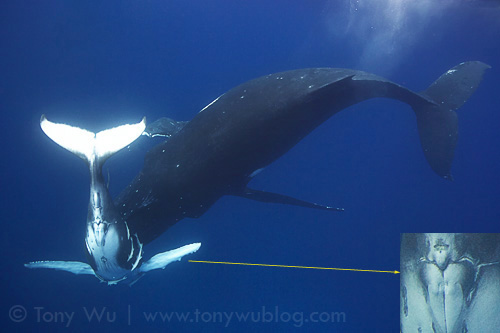
Female humpback calf 201217 with mommy
Love Me Two Times
In addition to the newly ID-ed calves, we had our first re-sighting for the season, female calf 201210 on 30 August. I first photographed this baby on 21 August.
As a photographer, my original purpose in traveling to Tonga was to create beautiful, inspiring images of the humpback whales that visit these waters each year. But being able to enter the water and observe whales directly affords me another opportunity...the chance to glean some insight into the lives of humpback whales.
Over the years, this has become as important to me, if not more so, than taking pictures. By the end of this season, I will have spent nearly 18 months of my life on and in the water here with the whales, probably more than any other person ever has. Over that time, I’ve seen and learned a lot, and each season, I look forward to recording everything I see and experience, then piecing together all the parts of the puzzle to try to figure out what the whales are doing.
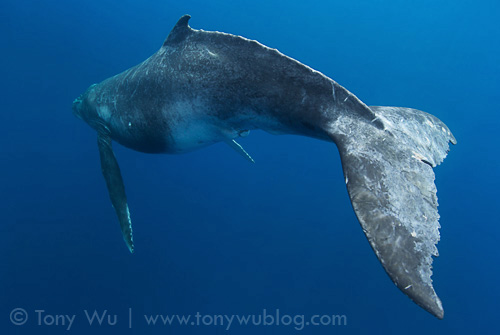
Humpback whale calf 201210...female, like most of the others so far this season
Calf 201010 and her mom are a perfect example.
After my first encounter with this mother/ calf pair, this is what I recorded:
“Female, calf, escort. Escort laid back. Mom somewhat wary, but not too bad. Calf very inquisitive and friendly, approaching swimmers multiple times.”
After a couple of swims, we left the whales in the care of another boat with some of my friends aboard. Shortly thereafter, the trio started to move, and the escort commenced singing. Four other males appeared, turning the situation into a heat run and making it impossible to keep up with the whales, much less enter the water.
Fast-forward nine days.
On the morning of 30 August, I spotted a trio of whales (mother, calf, escort) moving at high speed just south of the main islands of Vava’u, with another whale giving chase several hundred metres behind. We watched as the trailing whale joined the leading trio, resulting a spectacular display by the escort...grunting, crocodiling, snorting...dispatching the would-be challenger in short order with fluke tucked under his tail.
The three whales bounced around for a while, clearly worked up to some extent by the intrusion, eventually calming down enough that it looked as if we might have a chance to take a peek underwater.
Just as we were getting ready...another male appeared from nowhere. The boys went at it again, sending all the whales off at high speed in random directions, until the escort once again prevailed and sent the newcomer packing.
Once that was settled, the whales did eventually calm down, and we were able to get in and take a good look.
So putting all that together:
- Calf 201210 and mom probably stayed in the Vava’u area between 21 to 30 August.
- Mommy whale seems to be attractive, given that she merited the attention of at least seven male whales through two encounters.
- The calf was highly inquisitive and friendly in both encounters. Mommy was neutral at best in both encounters. In other words, their dispositions/ personalities remained consistent through the two encounters separated by nine days.
- Perhaps most interesting...Mommy whale switched allegiances during the 9-day period. The escort that was with her on 30 August was not the same one that was with her on 21 August. I didn’t get a great look at the earlier escort, but the one on 30 August was a monster of a male. He was gigantic, both in length and girth, which may help explain how he got rid of the two challengers so quickly.
Huh...maybe size does matter after all.
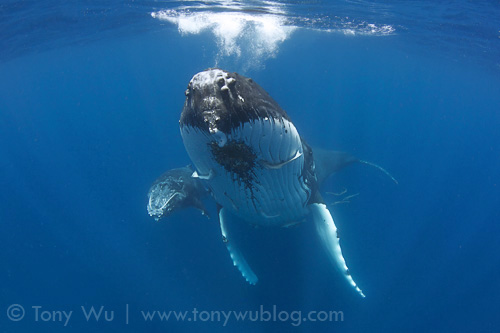
Second time around with humpback whale calf 201210 and mother
The Song Remains the Same
Those weren’t the only interesting observations though.
Just like the escort on 21 August, the big boy on 30 August started to sing after all the commotion had settled and the three whales stopped to rest: Escort the deepest, mommy above, and calf the most shallow...a typical configuration.
I’ve mentioned in seasons past that the humpbacks here sing in many situations (e.g. with mom/ calf, during heat runs, while swimming, while sitting horizontal, while hanging out with another whale, etc.), not just when they’re hanging head-down in the classic singer pose. This situation (and the singing escort with calf 201210) provided a perfect opportunity for me to share this information first-hand with my friends who are here with me now.
Floating not 15 metres above the whales, we watched as the calf nuzzled mommy, and escort belted out his best rendition of this season’s Megaptera melody.
Humpback whales make lots of sounds, so hearing a humpback vocalise doesn’t guarantee that you’ve heard THE song for the season. I’ve heard humpbacks vocalising for extended periods in a song-like manner, with a tune that wasn’t the actual song. In fact, my friend Dr. John Potter and I recorded a singer doing precisely this a couple of seasons ago, transitioning mid-melody into the actual song for that year.
But...in this case I’m 100% positive the escort was singing THE song, because later that day, we found a lone singer, courtesy of a pair of breaching/ playing whales that led us on a whirlwind tour for a while, then ditched us like yesterday’s news.
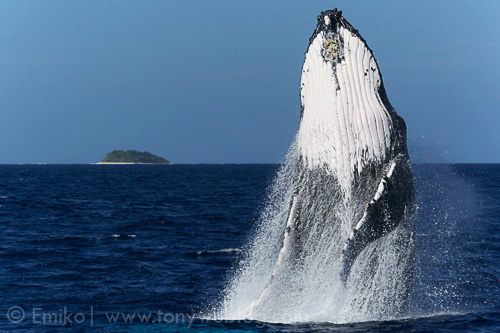
Breaching humpback whale in Tonga
We were in an area of horrendous visibility, with overcast skies, and the singer was deep (at least 30m down at the fluke), hanging in the classic head-down pose.
I took it as a personal challenge to find him, and fortunately managed to track him through three breath cycles over the period of 45 minutes or so. That gave me the opportunity to listen to the song over and over again. A couple of friends also recorded the audio on their cameras, so we were able to confirm later that the song was the same as the one the escort with calf 201210 performed.
Out of interest, this year’s song is characterised by a lot of scratchiness. The best I can describe it...is that parts of the tune sound almost as if the notes were being played on a badly out-of-tune squeaky violin.
I may be able to extract audio from my friends’ recordings and post it later. Posting large files is too much of a challenge right now, given limited and sporadic internet access. I can say that I don’t recall ever hearing so much scratchiness though. Also...the big booming bass is back, after not being so prominent in the song last year.
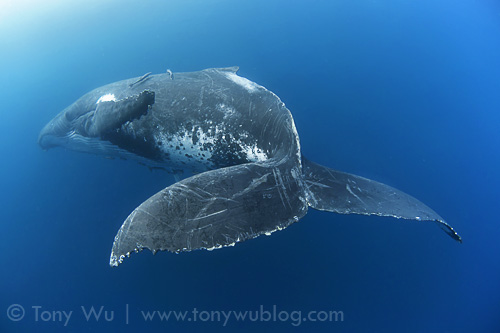
Humpback whale singer, Tonga
Waiting For A Girl Like You
We also watched “The Making Of A Calf”, so to speak this week, coming across at least one male/ female pair engaged in courtship.
I say at least one pair because I’m reasonably confident that the breaching whales that led us to the singer I highlighted above were also a courting couple (based on observing their behaviour), but I didn’t have an opportunity to get into the water and confirm by looking under their skirts, so I can’t be 100% certain.
In the case of the second pair, I am completely certain, as I had plenty of opportunity to observe them in clear water. Here’s a quick rundown of how things played out:
- Drop 1: The whales approached the boat of their own accord, swam slowly by, taking a good look at the boat and us, then kept going.
- Drop 2: The whale passed by once more. I swam along. When the whales were 15-20m ahead of me, the female did a 180 and turned back toward me, followed by the male. They swam straight for me, turned sideways when they were several metres away, stopped to look, then slowly swam away. The whales proactively checked me out.
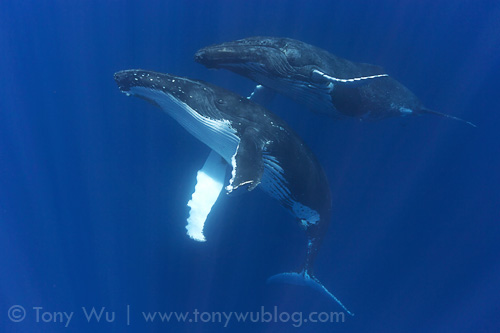
Pair of humpback whales turning to check me out
- Drop 3: The whales were traveling at speed. I dropped in, saw them change heading. I altered my course to meet them. As the whales appeared out of the blue haze, the female approached, looked at me, slowly turned sideways while descending to about 15m depth, blocking the male’s path. Then the whales came to a dead stop. They hung in the water, resting, looking at us for at least 15 minutes.
- Drop 4: The whales proactively approached people in the water...observing, circling, demonstrating what I can only describe as curiosity, perhaps even fascination.
While all this was happening, I was able to confirm visually that there was one male and one female. The inquisitive/ proactive nature of the whales was also consistent with past interactions I’ve had with male/ female pairs.
And finally, I now have a high degree of confidence in being able to confirm visually when a female humpback whale is ready to mate. In every case where I’ve encountered a female whale in a male/ female pair configuration or in a heat run, the female’s genital area has been discoloured and appears swollen/ engorged...as was the case once again in this experience.
Given the existence of outward signs of sexual receptivity in other mammals, I think it’s reasonable to propose that such discolouration + swelling is an indication of a female humpback whale’s readiness to mate. I’ll certainly keep an eye out for this in future encounters, but the first time I noticed this was in 2005, so I’m confident enough to state this publicly now.
We left the whales alone after our 4th drop. As we set off, I joked that I might be the world’s only whale wedding photographer, given that the pair were most likely on their way to consummating their nuptials:
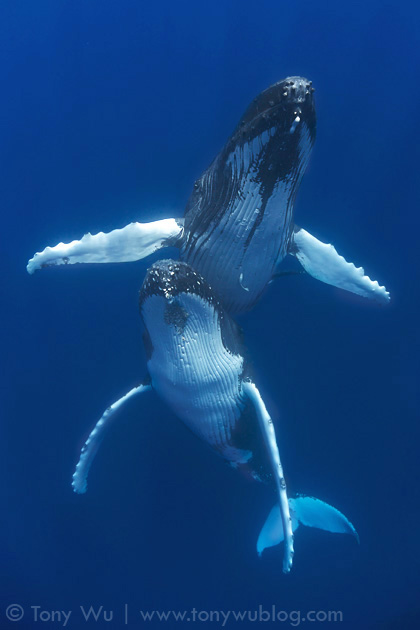
Female and male humpback whale engaged in courtship, Tonga
Shiny Happy People
This week saw a few comings and going.
My friends Jon, Bryn, Jack, Julian, Ildi, Ai Lin and TK wrapped up their stay and headed out. Jon, Bryn and Jack have moved to Ha’apai and will be there for another week. They’ve already had some good encounters, and I hope they’ll have many more during their stay. I’m counting on them to send me some calf photos for the calf count (hint, hint guys!)
Who knows? Maybe one of the babies from here will show up there, or vice versa.
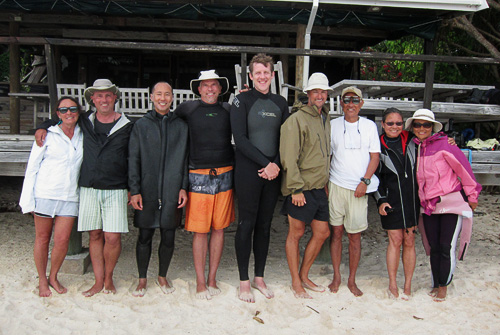
Ildi, Julian, me, Jack, Bryn, Jon, TK, Ai Lin and Emi
In their place, Serene, May, George, Debbie, Beverley and Karl arrived on Wednesday...just in time for the re-sighting of calf 201210, a crazy breach-fest, and the singers.
How fortunate I am to have such amazing people choose to travel with me. I am by nature a very private person, and I don’t suffer fools (such an understatement), so the fact that I have tremendously enjoyed the company of every single person I’ve had the privilege of sharing these experiences with really says a lot.
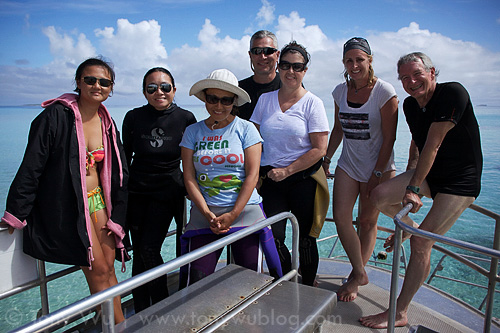
May, Serene, Emi, George, Debbie, Beverley, Karl at Mounu Island Resort
Being able to narrate what we see in real time and to recap the significance of our experiences during dinner conversation gives me great pleasure, and also affords me the opportunity to consolidate my own thoughts and conjectures. Thank you all.
Enough sappiness.
Both the weather and the mood of the whales has continued to be generally cooperative, so hopefully the week ahead will bring more exciting encounters and interesting insights into the behaviour of the whales.
Humpback Whales in Tonga | Part 1
Humpback Whales in Tonga | Part 2